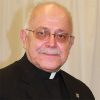Through the story of Mother Cabrini, Maryknoll Father Joseph Veneroso reflects on Jesus the healer and what devotion to the Most Sacred Heart teaches about healing.
As an Italian-American Catholic, I was raised on stories of Mother Frances Xavier Cabrini. The first U.S. citizen to be canonized, she is the patron saint of immigrants. My mother unknowingly implanted in my heart the desire to become a missioner when she read to me from Mother Cabrini’s biography Too Small a World.
Pope Leo XIII, reluctant to approve Sister Cabrini’s desire to form a new worldwide missionary order, confronted the Italian nun with her physical handicap: three religious orders had rejected her because of “weakness of constitution.” She calmly but firmly replied, “We can serve our weakness or our purpose; not both.”
Mother Cabrini suffered from chronic endocarditis, inflammation of the inner lining of the heart. Yet she outlived her terminal prognosis by three decades. She also founded the worldwide Missionary Sisters of the Sacred Heart. Her order opened hospitals, orphanages and schools from New York to Buenos Aires to Beijing, building “an empire of hope.” Their inspiration? The Most Sacred Heart of Jesus.
The image of the Sacred Heart of Jesus is shown crowned with thorns and pierced with a lance. Isaiah foretold the Messiah would be pierced and crushed, for “by his wounds we were healed” (53:5). After his resurrection, Jesus showed the incredulous apostles his wounds, not just to identify himself as the same one crucified three days earlier, but also to heal them of their doubts and fears.
But why are people attracted to the seemingly absurd notion of a crucified savior?
We are all wounded. One way or the other, by the time we reach adulthood everyone bears emotional, psychological, social, and spiritual — if not physical — scars, remnants of our personal battles. It’s the price we pay for being human.
After “Lord” and “Christ” the title most ascribed to Jesus by Christians is “Savior,” from the Latin salus. The term connotes not only salvation but also health.
While the translation of salus into “salvation” conveys an otherworldly sense, its Hebrew counterpart in Judaism, best translated as “deliverance,” has a tangible, down-to-earth dimension.
In Jesus’ day, multitudes of people sought him out primarily as a healer. We know only some of their names and stories. The Gospels tell of 10 lepers on the road, a woman with a hemorrhage, Peter’s mother-in-law and the blind man at Siloam pool. Friends tear a hole in the roof to let down their sick friend so Jesus might heal him.
In the Gospels, deliverance includes — but goes beyond — physical healing. Curing lepers included taking away not just their disfigurement, but their social stigma and isolation. The same happened in the healing of the woman with a hemorrhage. The man possessed by a “Legion” of demons was delivered by Jesus’ liberating power.
Yet in his hometown of Nazareth, Jesus was unable to heal more than a few people “because of their lack of faith” (Matthew 13:58). This makes his curing of the Roman centurion’s servant all the more scandalous. Imagine his countrymen’s shock when Jesus declared of this foreign oppressor: “In no one in Israel have I found such faith” (Matthew 8:10).
The connection between faith, salvation and healing is reinforced in the liturgy. Before receiving the Eucharist, we paraphrase the centurion’s response by saying, “but only say the word and my soul shall be healed.”
The greatest act of healing occurred at the Crucifixion — not for an individual or nation, but for all humanity in every age. Jesus is savior, healer and liberator of the wounded and broken human race for he, too, was wounded and broken. His pierced, bleeding heart draws to him people who feel wounded and beaten — that is, everyone.
Mother Cabrini’s insight still rings true. God heals our injuries and frailties by uniting them to Jesus’ Sacred Heart.
As Jesus’ wounds heal us, so our wounds can help heal others. Once we give them over to Christ, he can transform them into fonts of healing and grace.
Featured Image: St. Frances Xavier Cabrini is depicted in a stained-glass window at the saint’s shrine in the Washington Heights section of New York City. (OSV News photo/Gregory A. Shemitz)
![]()

